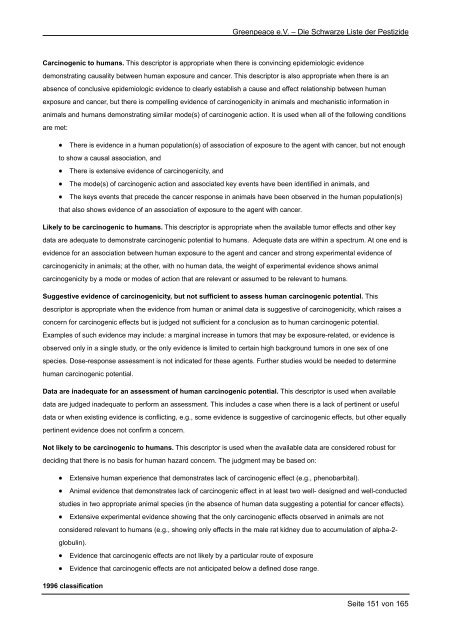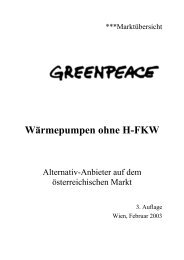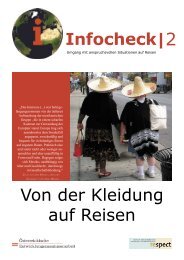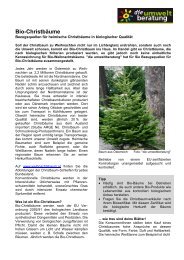Die Schwarze Liste der Pestizide - Greenpeace
Die Schwarze Liste der Pestizide - Greenpeace
Die Schwarze Liste der Pestizide - Greenpeace
Erfolgreiche ePaper selbst erstellen
Machen Sie aus Ihren PDF Publikationen ein blätterbares Flipbook mit unserer einzigartigen Google optimierten e-Paper Software.
<strong>Greenpeace</strong> e.V. – <strong>Die</strong> <strong>Schwarze</strong> <strong>Liste</strong> <strong>der</strong> <strong>Pestizide</strong><br />
Carcinogenic to humans. This descriptor is appropriate when there is convincing epidemiologic evidence<br />
demonstrating causality between human exposure and cancer. This descriptor is also appropriate when there is an<br />
absence of conclusive epidemiologic evidence to clearly establish a cause and effect relationship between human<br />
exposure and cancer, but there is compelling evidence of carcinogenicity in animals and mechanistic information in<br />
animals and humans demonstrating similar mode(s) of carcinogenic action. It is used when all of the following conditions<br />
are met:<br />
There is evidence in a human population(s) of association of exposure to the agent with cancer, but not enough<br />
to show a causal association, and<br />
There is extensive evidence of carcinogenicity, and<br />
The mode(s) of carcinogenic action and associated key events have been identified in animals, and<br />
The keys events that precede the cancer response in animals have been observed in the human population(s)<br />
that also shows evidence of an association of exposure to the agent with cancer.<br />
Likely to be carcinogenic to humans. This descriptor is appropriate when the available tumor effects and other key<br />
data are adequate to demonstrate carcinogenic potential to humans. Adequate data are within a spectrum. At one end is<br />
evidence for an association between human exposure to the agent and cancer and strong experimental evidence of<br />
carcinogenicity in animals; at the other, with no human data, the weight of experimental evidence shows animal<br />
carcinogenicity by a mode or modes of action that are relevant or assumed to be relevant to humans.<br />
Suggestive evidence of carcinogenicity, but not sufficient to assess human carcinogenic potential. This<br />
descriptor is appropriate when the evidence from human or animal data is suggestive of carcinogenicity, which raises a<br />
concern for carcinogenic effects but is judged not sufficient for a conclusion as to human carcinogenic potential.<br />
Examples of such evidence may include: a marginal increase in tumors that may be exposure-related, or evidence is<br />
observed only in a single study, or the only evidence is limited to certain high background tumors in one sex of one<br />
species. Dose-response assessment is not indicated for these agents. Further studies would be needed to determine<br />
human carcinogenic potential.<br />
Data are inadequate for an assessment of human carcinogenic potential. This descriptor is used when available<br />
data are judged inadequate to perform an assessment. This includes a case when there is a lack of pertinent or useful<br />
data or when existing evidence is conflicting, e.g., some evidence is suggestive of carcinogenic effects, but other equally<br />
pertinent evidence does not confirm a concern.<br />
Not likely to be carcinogenic to humans. This descriptor is used when the available data are consi<strong>der</strong>ed robust for<br />
deciding that there is no basis for human hazard concern. The judgment may be based on:<br />
Extensive human experience that demonstrates lack of carcinogenic effect (e.g., phenobarbital).<br />
Animal evidence that demonstrates lack of carcinogenic effect in at least two well- designed and well-conducted<br />
studies in two appropriate animal species (in the absence of human data suggesting a potential for cancer effects).<br />
Extensive experimental evidence showing that the only carcinogenic effects observed in animals are not<br />
consi<strong>der</strong>ed relevant to humans (e.g., showing only effects in the male rat kidney due to accumulation of alpha-2-<br />
globulin).<br />
Evidence that carcinogenic effects are not likely by a particular route of exposure<br />
Evidence that carcinogenic effects are not anticipated below a defined dose range.<br />
1996 classification<br />
Seite 151 von 165
















